
The Council of Sutri (or Synod of Sutri) was called by the Holy Roman Emperor Henry III and opened on December 20, 1046, in the hilltown of Sutri, at the edge of the Duchy of Rome. The Catholic Church does not list this as an ecumenical council.

The Council of Sutri (or Synod of Sutri) was called by the Holy Roman Emperor Henry III and opened on December 20, 1046, in the hilltown of Sutri, at the edge of the Duchy of Rome. The Catholic Church does not list this as an ecumenical council.
The Annales Romani record the events thus:
"Henry, most victorious king by the grace of God...When he arrived at the city of Sutri, he called the Roman clergy along with Pope Gregory to meet with him. He ordered a special synod to be held in the holy church of Sutri and there, lawfully and canonically, he sat in judgment upon Bishop John of Sabina, called Silvester; the archpriest John, called Gregory; and the aforementioned Pope Benedict." [1]
The council was called to resolve disorder over the papacy. A faction in the church encouraged Henry III to intervene, both to resolve the conflict and to receive his crown from the pope in an official ceremony. In the autumn of 1046 Henry III, already King of the Germans, crossed the Alps at the head of a large army and accompanied by a retinue of the secular and ecclesiastical princes of the empire, all of whom were his sworn vassals. Henry had two intentions, to be crowned Holy Roman emperor by the pope at Rome and, in order that the pontiff concerned have an unassailable title—one that would not cast doubts upon his conferred imperial title— to establish order in the Duchy of Rome.
Rome was in a state of warfare between noble factions, each of whom had a candidate they regarded as pope. A pope presided at St. Peter's, another at the Lateran and a third at Saint Mary Major. Two of them, Benedict IX, a scion of the counts of Tusculum, and Sylvester III of the Crescenzi clan, represented rival factions of the Roman nobility. The claim of the third, Gregory VI, was peculiar in that he had purchased the title in good faith from Benedict IX two years previously. [2] Each claimant had a number of supporters in the Roman church and held a portion of the city.
Henry was met by Gregory at Piacenza and was received with honor. It was decided that a synod should meet at Sutri, some 40 km north of Rome, well beyond the city's factional violence. Before the assembly Gregory testified that he had, "in all good faith and simplicity," purchased the papacy from Pope Benedict IX in 1044. After the departure of Benedict, the Bishop of Sabina had also declared himself pope, as Sylvester III. In 1045 Benedict, not having received his pay-off, returned to Rome and renewed his claim to the papacy.
The council summoned the three pontiffs, and both Sylvester and Gregory attended. The claims of all three popes were quickly dismissed. Sylvester was stripped of his sacerdotal rank and exiled to a monastery. Gregory resigned (his words were recorded as: "I, Gregory, bishop, servant of the servants of God, do hereby adjudge myself to be removed from the pontificate of the Holy Roman Church, because of the enormous error which by simoniacal impurity has crept into and vitiated my election."), and the council ended on December 23. A form of the council was repeated in Rome the following day to oversee the dismissal of Benedict. The papacy was declared to be sede vacante .
On December 24–25 Henry turned first to the powerful Adalbert, Archbishop of Bremen, who refused the dangerous honor. Henry's next choice for the papacy was his personal confessor, Suidger, Bishop of his recently created See of Bamberg. Suidger became the new pope, taking the title Clement II, but insisting on retaining the See of Bamberg, which was a source of financial support beyond the reach of Roman factions. He was immediately enthroned on Christmas Day.
As his first pontifical act, Clement II placed the imperial crown upon his benefactor and the queen consort, Agnes, daughter of William V, Duke of Aquitaine. The new emperor received from the Romans and the pope the title and diadem of a Roman Patricius, a dignity with antecedents in the Late Roman Empire, which since the tenth century had been assumed to confer the right to nominate the pontiff. Within a few decades the Gregorian Reforms would call this custom into question.
Benedict would again renew his claim to the papacy in 1047, when Clement II died.

The pope is the bishop of Rome and the visible head of the worldwide Catholic Church. He is also known as the supreme pontiff, Roman pontiff, or sovereign pontiff. From the eighth century until 1870, the pope was the sovereign or head of state of the Papal States, and since 1929 of the much smaller Vatican City state. From a Catholic viewpoint, the primacy of the bishop of Rome is largely derived from his role as the apostolic successor to Saint Peter, to whom primacy was conferred by Jesus, who gave Peter the Keys of Heaven and the powers of "binding and loosing", naming him as the "rock" upon which the Church would be built. The reigning pope is Francis, who was elected on 13 March 2013.
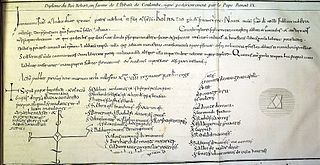
Pope Benedict IX, born Theophylactus of Tusculum in Rome, was the bishop of Rome and ruler of the Papal States for three periods between October 1032 and July 1048. Aged about 20 when first elected, he is the youngest pope in history, however some sources believe he could have been as young as 12. He is the only person to have been Pope more than once and the only person ever accused of selling the papacy.
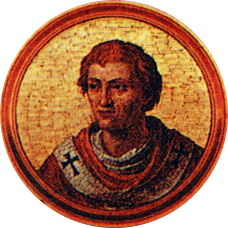
Pope Clement II was head of the Catholic Church and ruler of the Papal States from 25 December 1046 until his death in 1047. He was the first in a series of reform-minded popes from Germany. Suidger was the bishop of Bamberg. In 1046, he accompanied King Henry III of Germany, when at the request of laity and clergy of Rome, Henry went to Italy and summoned the Council of Sutri, which deposed Benedict IX and Sylvester III, and accepted the resignation of Gregory VI. Henry suggested Suidger as the next pope, and he was then elected, taking the name of Clement II. Clement then proceeded to crown Henry as emperor. Clement's brief tenure as pope saw the enactment of more stringent prohibitions against simony.
Pope Gregory VI, born Giovanni Graziano in Rome, was bishop of Rome and ruler of the Papal States from 1 May 1045 until his resignation at the Council of Sutri on 20 December 1046.
Pope Sylvester III, born John in Rome, was Bishop of Rome and hence ruler of the Papal States from 20 January to 10 March 1045.

Pope Victor III, was the head of the Catholic Church and ruler of the Papal States from 24 May 1086 to his death. He was the successor of Pope Gregory VII, yet his pontificate is far less notable than his time as Desiderius, the great abbot of Monte Cassino.

Pope Gregory VII, born Hildebrand of Sovana, was head of the Catholic Church and ruler of the Papal States from 22 April 1073 to his death in 1085. He is venerated as a saint in the Catholic Church.

The Avignon Papacy was the period from 1309 to 1376 during which seven successive popes resided in Avignon rather than in Rome. The situation arose from the conflict between the papacy and the French crown, culminating in the death of Pope Boniface VIII after his arrest and maltreatment by Philip IV of France. Following the subsequent death of Pope Benedict XI, Philip pressured a deadlocked conclave to elect the Archbishop of Bordeaux as pope Clement V in 1305. Clement refused to move to Rome, and in 1309 he moved his court to the papal enclave at Avignon, where it remained for the next 67 years. This absence from Rome is sometimes referred to as the "Babylonian captivity" of the Papacy.

Year 1046 (MXLVI) was a common year starting on Wednesday of the Julian calendar.
Pope Damasus II was the Bishop of Rome and ruler of the Papal States from 17 July 1048 to his death on 9 August that same year. He was the second of the German pontiffs nominated by Emperor Henry III. A native of Bavaria, he was the third German to become pope and had one of the shortest papal reigns.

Sutri is an Ancient town, modern comune and former bishopric in the province of Viterbo, about 50 kilometres (31 mi) from Rome and about 30 kilometres (19 mi) south of Viterbo. It is picturesquely situated on a narrow tuff hill, surrounded by ravines, a narrow neck on the west alone connecting it with the surrounding country. It is one of I Borghi più belli d'Italia.
A papal renunciation also called a papal abdication, occurs when the current pope of the Catholic Church voluntarily resigns his position. As a pope's time in office has conventionally lasted from his election until his death, a papal renunciation is an uncommon event. Before the 21st century, only five popes unambiguously resigned with historical certainty, all between the 10th and 15th centuries. Additionally, there are disputed claims of four popes having resigned, dating from the 3rd to the 11th centuries; a fifth disputed case may have involved an antipope.
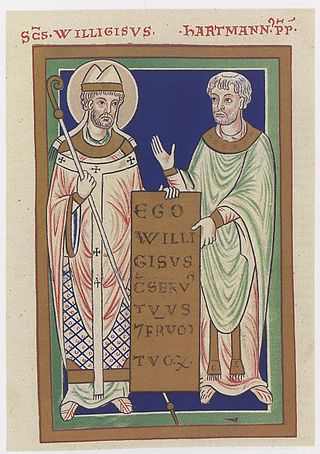
Willigis was Archbishop of Mainz from 975 until his death as well as archchancellor of the Holy Roman Empire.
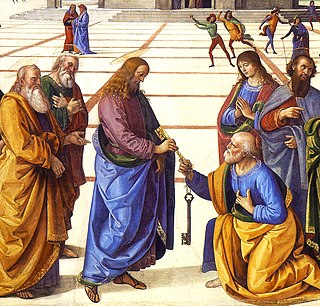
According to Roman Catholicism, the history of the papacy, the office held by the pope as head of the Catholic Church, spans from the time of Peter to the present day.
In nomine Domini is a papal bull written by Pope Nicholas II. The bull was issued on 13 April 1059 and caused major reforms in the system of papal election, most notably establishing the cardinal-bishops as the sole electors of the pope, with the consent of minor clergy.

Papal appointment was a medieval method of selecting the Pope. Popes have always been selected by a council of Church fathers; however, Papal selection before 1059 was often characterized by confirmation or nomination by secular European rulers or by the preceding pope. The later procedures of the Papal conclave are in large part designed to prohibit interference of secular rulers, which to some extent characterized the first millennium of the Roman Catholic Church, e. g. in practices such as the creation of crown-cardinals and the claimed but invalid jus exclusivae. Appointment may have taken several forms, with a variety of roles for the laity and civic leaders, Byzantine and Germanic emperors, and noble Roman families. The role of the election vis-a-vis the general population and the clergy was prone to vary considerably, with a nomination carrying weight that ranged from nearly determinative to merely suggestive, or as ratification of a concluded election.
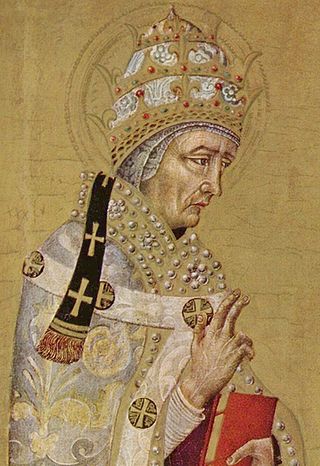
The selection of the Pope, the Bishop of Rome and Supreme Pontiff of the Catholic Church, prior to the promulgation of In Nomine Domini in AD 1059 varied throughout history. Popes were often putatively appointed by their predecessors or by political rulers. While some kind of election often characterized the procedure, an election that included meaningful participation of the laity was rare, especially as the Popes' claims to temporal power solidified into the Papal States. The practice of papal appointment during this period would later result in the putative jus exclusivae, i.e., the claimed but invalid right to veto the selection that Catholic monarchs exercised into the twentieth century.
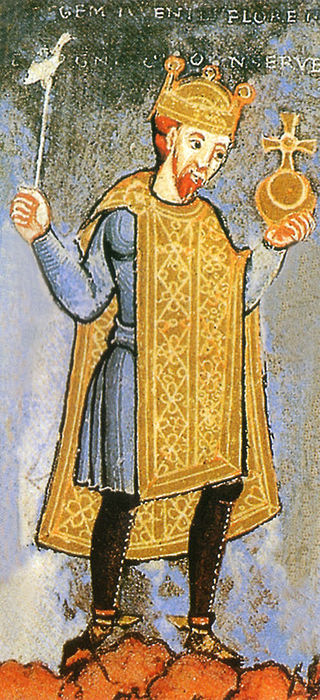
The history of the papacy from 1046 to 1216 was marked by conflict between popes and the Holy Roman Emperor, most prominently the Investiture Controversy, a dispute over who— pope or emperor— could appoint bishops within the Empire. Henry IV's Walk to Canossa in 1077 to meet Pope Gregory VII (1073–85), although not dispositive within the context of the larger dispute, has become legendary. Although the emperor renounced any right to lay investiture in the Concordat of Worms (1122), the issue would flare up again.
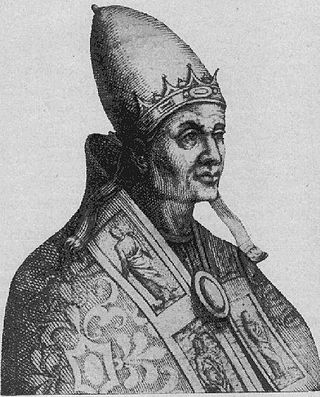
The Tusculan Papacy was a period of papal history from 1012 to 1048 where three successive relatives of the counts of Tusculum were installed as pope.
The Synod of Brixen was a church council held on 15 June 1080 in the episcopal city of Brixen. It was convoked by King Henry IV of Germany at the height of the Investiture Controversy to pass judgement on Pope Gregory VII. The synod issued a decree condemning the pope, demanding his abdication and authorizing his deposition if he refused. The synod also elected his successor, Wibert of Ravenna.